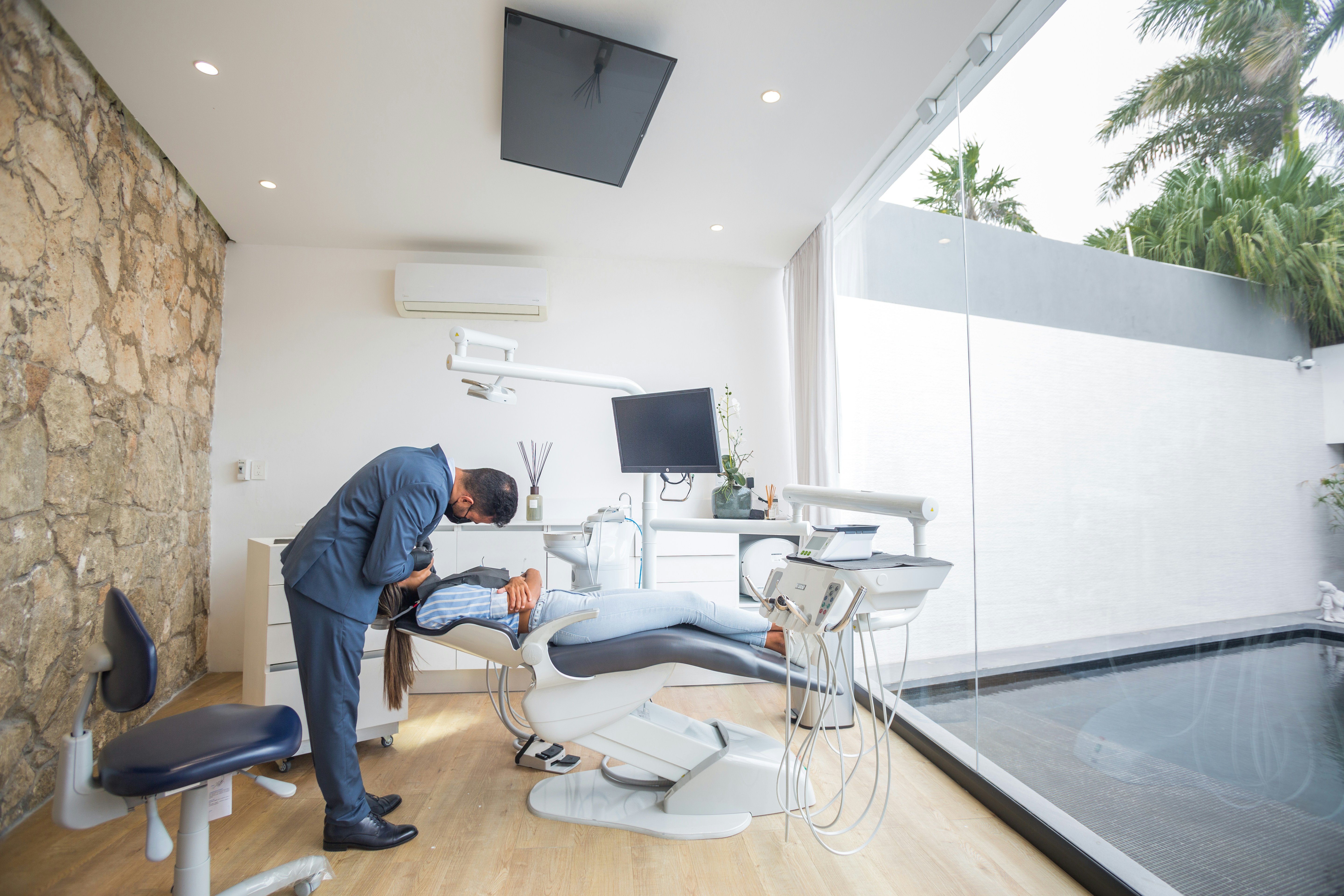Starting a dental practice from scratch is an exciting venture that combines strategic planning and practical execution. Find out how to open a dental practice with our guide, as we cover the following:
- What is a squat dental practice?
- Differentiating the practice
- Finding the perfect location
- Regulation and compliance for dentists
- Financing your dental practice
- Crafting a marketing strategy
- Building your team
- Designing your practice
- Executing a professional fit-out
- Equipping your clinic
- Maintaining your practice
- How Dojo can help
- FAQs
From the ground up: What is a squat dental practice?
A squat dental practice is a new dental clinic started from scratch. It involves:
- location scouting
- staff hiring
- building a patient base
- developing a pricing strategy
- deciding on treatment, and more.
Making your mark: Differentiating the practice
In today’s competitive dental market, standing out is key. Offering specialised services, using the latest technology, and providing great patient care are a must. These benefits make practices stand out and offer an incentive for patients to register.
Prime position: Finding a location
Choosing the perfect location for a squat dental practice takes careful planning and research. Here are some essential factors to keep in mind when considering how to open a dental clinic.
Start with a plan
Begin the search with a solid business plan for dental practices in place. Finding a ready-to-use dental office is rare, so be open to converting existing buildings.
Understand the locale
- Choose a location that is familiar or has been well-studied.
- Match the local population to the target patient base.
- Check out existing dental practices in the area and the services they offer.
Maximise accessibility and visibility
- Look for spots with plenty of pedestrian traffic for extra visibility.
- Ample parking is a big advantage for patient convenience.
- Ensure the location is easily accessible by public transportation.
Building requirements
- Good parking and disabled access.
- Enough ventilation for dental equipment.
- Make sure there is enough space for all necessary facilities and future growth.
- Make sure the look and feel of the building create a good, welcoming impression.
The rulebook: Regulation and compliance for dentists
Navigating the world of regulations might seem tricky, but it’s all about keeping things smooth and ensuring your standards stay top-notch. Staying compliant isn’t just about ticking boxes it’s about maintaining trust and delivering the best care possible. Here’s what to keep in mind:
Understanding regulatory bodies
- General Dental Council (GDC): Dentists need to be registered with the GDC. They oversee dental professionals in the UK and make sure everyone meets the necessary standards.
- Care Quality Commission (CQC): All squat dental practices in England have to register with the CQC. They check and inspect services to ensure everything is safe and meets quality standards.
Health and safety standards
- Infection control: It's important to have strict infection control measures in place to protect both patients and staff. This means properly sterilising instruments and keeping the practice clean.
- Health and safety compliance: Make sure the practice follows all health and safety regulations, including fire safety, waste disposal, and risk assessments.
Training and compliance
- Ongoing training: Regularly updating skills and knowledge through regular professional development (CPD) is key. It helps meet GDC requirements and maintains high standards of care for everyone.
- GDPR compliance: Make sure the squat dental practice complies with the General Data Protection Regulation (GDPR) to protect patient information.
Planning permissions
When setting up a dental practice, it's important to understand the ins and outs of planning permissions and building regulations.
- Defining the space: Dental practices are generally categorised under non-residential use, previously known as D1 under the Town and Country Planning Order of 1987. Recent updates have shifted this to Class E, which covers various commercial and service-based uses.
- Making it official: If the property you’ve chosen is currently residential or used for something else, like retail, you’ll need to apply for permission to change its use. This step is important to meet zoning regulations and ensure the space is legally ready for your practice. Need help? It’s always a good idea to check with your local planning authority or work with a professional who knows the logistics of property conversions for healthcare.
- Seeking professional help: Bringing in experienced dental fit-out consultants can be incredibly helpful. These experts can guide owners through the legal requirements and help with the application process.
Money moves: Financing your dental practice
Getting the finances right is a big part of how to open a dental practice.
How to open a private dental clinic
- First investment: Launching a private dental practice takes a pretty hefty upfront investment. This usually covers property, renovations, equipment, staffing, and marketing.
- Funding options: Explore funding options such as personal savings, bank loans, or bringing in investors. Look into dental-specific financing programs for tailored financial support.
- Revenue streams: Income can come from a range of services, including routine check-ups, cosmetic dentistry, and specialised treatments.
- Financial management: Budget for ongoing expenses, manage cash flow, and plan for growth and unexpected costs.
How to open a dental office with NHS funding
- NHS contracts: Securing an NHS contract is a big step. It involves applying through the NHS England procurement process to provide care to NHS patients.
- Funding and payments: If your practice is NHS-funded, payments are based on the number of UDAs you complete. It’s important to get familiar with how this works and make sure you stay compliant with NHS standards.
- Balancing services: Alongside providing NHS services, practices can offer private treatments to increase income. This mix helps boost revenue while meeting NHS requirements.
- Compliance and reporting: NHS practices follow strict rules, but regular audits and performance reviews are there to help keep standards high and funding running smoothly.
Your practice, your brand: Crafting a marketing strategy
Creating a strong marketing strategy is essential when starting a new dental practice.
- Digital presence: Create a professional website and stay active on social media to connect with potential patients.
- Beyond digital: Use traditional methods like local print ads and leaflet drops to reach the community.
- Early engagement: Start promoting early. Organise an opening event and issue a press release to generate buzz.
- Community collaboration: Partner with local health businesses for mutual promotion.
- Promotional offers: Attract new patients with free initial check-ups and referral schemes.
- Budgeting for marketing: Set a realistic budget for marketing campaigns and consider getting expert help for the best results.
Hiring right: Building your staff
Building a strong team is the backbone of opening a dental clinic.
- Practice manager: An essential role for handling day-to-day operations, freeing up the dentist to focus on patient care.
- Delegating responsibilities: Hire staff to manage appointments, supplies, compliance, maintenance, HR, administrative tasks, and marketing support.
- Key roles: Receptionists, supply managers, compliance officers, HR managers, administrative staff, cleaning and infection control personnel.
Style and function: Designing your practice
When considering how to open a dental clinic, creating the ideal environment involves more than just room layouts.
- Efficient traffic flow and comfort: Make sure staff and patients can move around easily.
- Customer experience: Create welcoming reception and waiting areas that leave a great first impression.
- Workflow and infection control: Design the space to support infection control with a smart 'dirty-to-clean' workflow.
Setting the stage: Executing a professional fit-out
When considering how to open a dental office, seeking expert opinion is key.
- Expert consultation: Experienced project managers can help anticipate challenges and offer practical solutions.
- Knowledgeable team: Collaborate with designers, dental engineers, and project managers who understand dental fit-outs.
- Qualified contractors: Choose contractors with expertise in medical facilities to ensure all specialised requirements are met.
Tools of the trade: Equipping your clinic
High-quality equipment are must-have for building a successful squat dental practice.
- Latest technology: Invest in digital X-rays, sterilisation units, and patient management software to stay ahead.
- Reliable tools: Choose dependable equipment to improve patient care and keep your practice running smoothly.
Regular upkeep: Maintaining your practice
Regular maintenance: Keeping up with maintenance is key to running your squat dental practice smoothly.
- Routine checks: Stay on top of regular servicing and checks to avoid unexpected equipment issues.
- Clean environment: A clean, hygienic space isn’t just essential for safety – it helps patients feel confident in your care.
- Preventive care: Regular upkeep keeps everything in top shape and makes your equipment last longer.
Seamless care, simplified payments
Smooth, hassle-free payments are essential for any dental practice. Start accepting card payments and virtual terminals to keep transactions seamless and your clinic running efficiently.
Merchant services designed for dental clinics cut down on admin work, letting you focus on patient care. And for even more convenience, payment links make it easy for patients to pay online quickly and securely.
For more tips and detailed guides to help run your business, check out our blog and find out how we helped Infinityblu scale through seamless payments.



